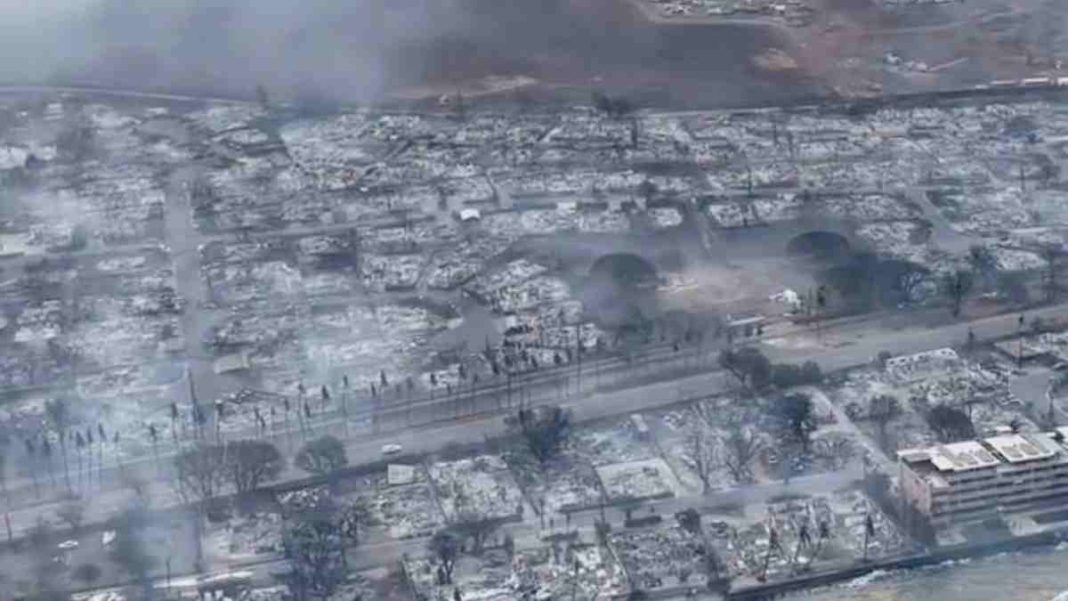MAUI: On Friday, the death count resulting from the Maui wildfires climbed to 80 as search squads scoured through the still-smouldering remains of Lahaina, while Hawaiian authorities aimed to ascertain the swift and unexpected spread of the blaze in the historic resort town.
This incident marked the most lethal natural catastrophe in Hawaii’s history, exceeding the toll of a 1960 tsunami on the Big Island, which claimed 61 lives shortly after Hawaii’s incorporation into the United States.
Authorities have cautioned that search teams accompanied by cadaver dogs might discover additional casualties from the fire that destroyed 1,000 structures and displaced thousands of residents, likely requiring many years and billions of dollars to rebuild.
“Nobody has entered any of these structures that have burned down, and that’s where we unfortunately anticipate that the death toll will rise significantly,” stated U.S. Senator Brian Schatz of Hawaii in an interview with MSNBC.
During a statement in the late evening, Maui County reported that the number of casualties had climbed to 80.
The Lahaina fire, which extended from the brush to the town, was still active but under control at 85%, as stated earlier by the county. Meanwhile, two other wildfires on the island were reported to be 80% and 50% contained.
Even after three days had passed since the tragedy, it was still unclear whether some residents had received warnings before the fire destroyed their homes.
Despite the presence of emergency sirens designed to warn about natural disasters and other dangers on the island, there were no indications that they had been activated during the fire.
Hawaii Governor Josh Green told CNN that he had “authorised a comprehensive review this morning to make sure that we know exactly what happened and when.”
Officials have not provided specifics regarding the notifications that were distributed or whether they were delivered via text message, email, or phone calls.
Green explained that there were several concurrent difficulties, including disrupted telecommunications and firefighters focusing on larger wildfires, when the most significant danger to Lahaina emerged.
During the incident, he mentioned, “We will do all that we can to find out how to protect our people more going forward.”
At a press briefing last Thursday, Maui County Fire Chief Bradford Ventura explained that the rapid pace of the fire made it extremely challenging for frontline responders to coordinate with emergency management officials, who usually issue immediate evacuation instructions.
“They were basically self-evacuating with fairly little notice,” he stated, referring to the inhabitants of the neighbourhood where the fire initially struck.
County Mayor Richard Bissen said the fire advanced quite quickly, but he was unsure if alarms had sounded when he appeared on NBC’s “Today” show on Friday.
He added, “I think this was an impossible situation.”
Just after midnight on Tuesday, a brush fire was detected in the town of Kula, which is about 35 miles (56 km) from Lahaina. This is when the catastrophe started to take place. Power was lost in Lahaina about five hours later that morning, according to locals.
In updates published that morning on Facebook, Maui County stated that while the Kula fire had destroyed hundreds of acres of pastureland, a tiny brush fire that had broken out in Lahaina had been extinguished.
However, things had gotten worse by that afternoon. The Lahaina fire suddenly erupted at roughly 3:30 p.m., according to the county’s updates. The west portion of the town was told to stay in place while some residents started to evacuate, including hotel guests.
The county issued a number of more evacuation orders on Facebook throughout the course of the next few hours as the fire spread throughout the town.
Some witnesses stated that they had little warning and described their panic as the fire quickly destroyed Lahaina in what seemed like a matter of minutes. In order to save themselves, a number of people had to jump into the Pacific Ocean.
According to Andrew Rumbach, a climate and communities specialist at the Urban Institute in Washington, there were only, at best, two ways out of Lahaina because of its coastal location next to hills.
On Friday, county officials started letting Lahaina residents return to their homes, despite the fact that much of Maui’s western half was still without power and water.
But after a pedestrian was killed in an accident and the Kuihelani Highway was shut down in both directions, the Kuihelani traffic bottleneck came to an abrupt end.
Health officials warned that the burned regions were highly toxic and that breathing in dust and other airborne particles was dangerous; therefore, police cordoned off central Lahaina.
“Hot spots still exist, and wearing a mask and gloves is advised,” Maui County stated.
Also Read: Maui in Flames: Hawaii Wildfires Claim Six Lives in Devastating Blaze



